Backyard Bird Feeding, Featured
About Wild Bird Feeds
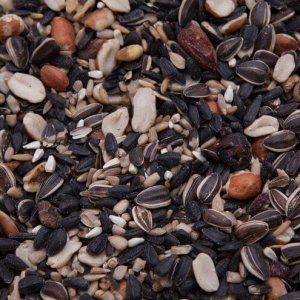
When we shop for groceries we often find ourselves reading labels to see what ingredients are in our food. When we purchase food for our pets we read labels to assure we are buying a quality product that provides the nutrition they need to keep healthy. When we purchase wild bird feed for our backyard feathered friends we should pay close attention to what is listed on the label. It may not be a quality product preferred by birds.
The “ideal diet” for many birds in the wild is high in fats and proteins…the opposite of ours as humans. Sunflower, safflower, Nyjer and peanuts range between 20-25% protein and 20-40% fat. That’s why they make up the majority of Wild Bird Habitat’s favorite high quality bird feed mixes. You’ll find “cheap” mixes full of milo, wheat, red millet, and assorted grain products birds don’t care for. Most all of these “low cost” seed mixes only contain 8-12% protein and 2-4% fat. The evidence is on the ground where as much as 40% of it will end up scattered on the ground and go by the uneaten by birds. The bottom line is; paying a little more for a quality wild bird feed will save you money in the long run avoiding wasted uneaten seed on the ground and attracting more birds to your feeders.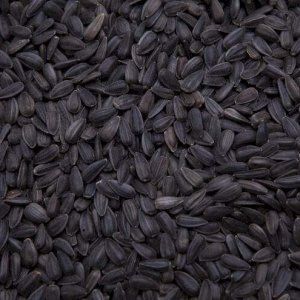
And the black oil sunflower seed we purchase for backyard bird feeding is not all the same either. Highly discounted black oil sunflower seeds are often those which did not reach maturity due to an early frost, insects, or disease. Birds are capable of weighing sunflower seeds for the heart inside. They can identify which seed we offer in our backyard bird feeders are high in protein & fats and will not waste their time on seeds that provide insufficient nutrition.
A bird must consume as much feed as they can in a short period of time. Since they are on constant alert for predators and continuously competing with other birds, they don’t have a lot of time to pick through a seed mixture or test every black oil sunflower seed. If inferior or low quality wild bird feeds are offered in our backyard bird feeders it doesn’t take long for birds to lose interest and move on. (NOTE: White Proso Millet is a preferred small seed found in most wild bird mixes. However many other types of millet and small seeds resemble White Proso Millet, but are not attractive as a food source to songbirds.)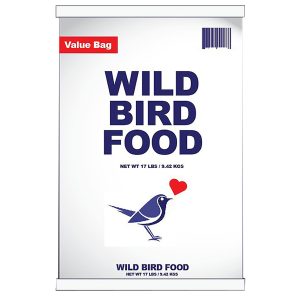
So how can the consumer decide which bag of wild bird feed is going to attract their favorite birds and keep them coming back for more? What do we need to look for on the label of a bag of wild bird feed to make certain we are providing a product that offers the ultimate nutrition for our backyard birds? Here are some tips on reading labels on bags of wild bird feeds:
1. Wild bird feed mixes are required by law to list the actual ingredients they contain and labeled in an order of contents from greater to least of each ingredient. However some labels may state “assorted grain products”. These are commonly weed seeds and cereal grains birds do not eat. These filler seeds are added to bulk up the weight of the bag and lower the cost. (Studies conducted at Oregon State University found that bird seed mixes are often contaminated with noxious or invasive weed seeds birds do not eat)
2. All ingredients used in wild bird feeds must be correctly identified in the ingredient section.
3. Read labels carefully. Watch for questionable statements & misleading label Information.
For example: products claiming to have nuts, fruits and other ingredients should have those ingredients specifically listed in the ingredient section on the bag or label.
4. Every wild bird seed label must have guaranteed levels of crude protein, crude fat, crude fiber and moisture.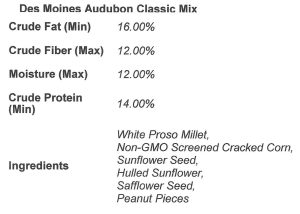
5. Check to see if the wild bird feed you offer is certified NON-GMO. Given a choice, birds and animals prefer and will select non-GMO grains?
Crude Protein provides the building blocks for good health supporting the immune system, feather production, egg laying and essentially keeping birds healthy.
Crude Fat provides the energy birds need to go about daily activities and the energy they need to stay warm through cold winter nights. Birds can burn up tens of thousands of calories in a day. Without a minimal amount of body fat to store energy they must constantly forage for food to maintain optimal energy levels.
Crude Fiber necessary in the diet to promote normal movement of food through the bird’s digestive tract.
Moisture provides a medium for digestion, absorption, transport, and metabolism
So when you shop for wild bird feeds consider this:
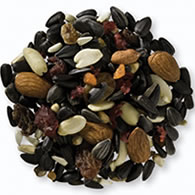
- Wild bird feed mixes are required to list the actual ingredients they contain and labeled in an order of contents from greater to least of each ingredient.
- All ingredients used inwild bird feeds must be correctly identified in the ingredient section.
- Labels on wild bird feeds should specify if it meets the Association of American Feed Control Officials (AAFCO)
- Read labels carefully. Watch for questionable statements & misleading label Information.
For example: products claiming to have nuts, fruits and other ingredients should have those ingredients specifically listed in the ingredient section on the bag or label. - Every wild bird seed label must have guaranteed levels of crude protein, crude fat, crude fiber and moisture.
- Is the wild bird feed you offer certified NON-GMO)
The bottom line is – paying a little more for a quality wild bird feed will save you money in the long run avoiding wasted uneaten seed on the ground and attracting more birds to your feeders.
NOTE: If using a general wild bird mix that has White Proso Millet as a base in an elevated feeder, you may find much of the millet on the ground. This is caused by birds sweeping through the mix to pick out the sunflowers, safflower, and peanuts. Many ground feeding birds will feed on the millet under the feeder. However if you want to avoid this use black oil sunflower seed, hulled sunflower seed, safflower or nutra safflower, or a nut based mix in your elevated feeders. Use the general wild bird mixes on platform type bird feeders and griund feeders.
About Nyjer Thistle Seed

You just purchased a new bag of Nyjer thistle seed and filled your thistle feeder, but no goldfinches are coming. Why is that? Caution must be taken to assure the thistle seed you purchase is fresh or the finch you are trying to attract will reject it. Nyjer thistle seed is imported from Ethiopia, Burma, and India. When it reaches North America it is sterilized by heat treatment to deter the germination of noxious weeds. This starts a drying out of the oils in the seed which is what attracts the finch. If Nyjer thistle seed is warehoused for extended periods of time before it reaches the shelf for the consumer to purchase, such as at big box stores, hardware stores, and grocery stores, it can lead to the oils drying out even more. At that point the finch will ignore it. We recommend buying Nyjer thistle seed from a reputable retailer.
When selecting a “finch mix” read the label carefully. Avoid finch mixes with Reed Canary Grass Seed. This is an invasive grass that can choke out streams and wetlands and is hard to control. Many other seeds in a finch mix are considered fillers. Use a finch mix that is limited to fine sunflower chips and Nyjer thistle seed. You can easily mix your own using 50 to 50 of each.
